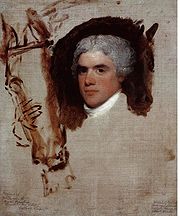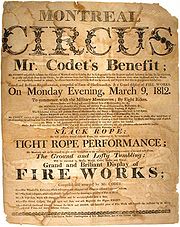
Circus of Pepin and Breschard
Encyclopedia

Victor Pépin
Victor Pépin was an American circus performer and circus owner most famous for being a partner in the Circus of Pépin and Breschard. Victor Adolphus Pépin, the eldest son of André Pepin, a Canadian who fought for the Americans in their Revolution against the British, was born in Albany, New York...
and Frenchman Jean Baptiste Casmiere Breschard
Jean Baptiste Casmiere Breschard
Jean Baptiste Casmiere Breschard was a circus owner and equestrian performer in the Circus of Pepin and Breschard.Frenchman Breschard reintroduced the circus clown to the United States in 1807. Mme. Breschard, wife of Jean Baptiste, was a premier equestrienne and is described in numerous sources...
, arrived in the United States of America from Madrid
Madrid
Madrid is the capital and largest city of Spain. The population of the city is roughly 3.3 million and the entire population of the Madrid metropolitan area is calculated to be 6.271 million. It is the third largest city in the European Union, after London and Berlin, and its metropolitan...
, Spain
Spain
Spain , officially the Kingdom of Spain languages]] under the European Charter for Regional or Minority Languages. In each of these, Spain's official name is as follows:;;;;;;), is a country and member state of the European Union located in southwestern Europe on the Iberian Peninsula...
(where they had performed during the 1805 and 1806 seasons), in November 1807. They toured that new country until 1815. From their arrival until the present day, what is now known as the traditional circus
Circus
A circus is commonly a travelling company of performers that may include clowns, acrobats, trained animals, trapeze acts, musicians, hoopers, tightrope walkers, jugglers, unicyclists and other stunt-oriented artists...
has had a presence in North America
North America
North America is a continent wholly within the Northern Hemisphere and almost wholly within the Western Hemisphere. It is also considered a northern subcontinent of the Americas...
.
Invited to perform in the United States by Spanish Ambassador Luis de Onís, the company landed in Plymouth, Massachusetts from Spain. They performed their first season in Charlestown, Massachusetts
Charlestown, Massachusetts
Charlestown is a neighborhood of Boston, Massachusetts, United States, and is located on a peninsula north of downtown Boston. Charlestown was originally a separate town and the first capital of the Massachusetts Bay Colony; it became a city in 1847 and was annexed by Boston on January 5, 1874...
, after being refused a permit to perform in neighboring Boston
Boston
Boston is the capital of and largest city in Massachusetts, and is one of the oldest cities in the United States. The largest city in New England, Boston is regarded as the unofficial "Capital of New England" for its economic and cultural impact on the entire New England region. The city proper had...
.

Circus
A circus is commonly a travelling company of performers that may include clowns, acrobats, trained animals, trapeze acts, musicians, hoopers, tightrope walkers, jugglers, unicyclists and other stunt-oriented artists...
theatres in cities across the United States, including New York, New York; New Orleans; Charlestown, Massachusetts; Baltimore, Maryland; Richmond, Virginia
Richmond, Virginia
Richmond is the capital of the Commonwealth of Virginia, in the United States. It is an independent city and not part of any county. Richmond is the center of the Richmond Metropolitan Statistical Area and the Greater Richmond area...
; Alexandria, Virginia
Alexandria, Virginia
Alexandria is an independent city in the Commonwealth of Virginia. As of 2009, the city had a total population of 139,966. Located along the Western bank of the Potomac River, Alexandria is approximately six miles south of downtown Washington, D.C.Like the rest of northern Virginia, as well as...
; Charleston, South Carolina
Charleston, South Carolina
Charleston is the second largest city in the U.S. state of South Carolina. It was made the county seat of Charleston County in 1901 when Charleston County was founded. The city's original name was Charles Towne in 1670, and it moved to its present location from a location on the west bank of the...
; Pittsburgh and Philadelphia, Pennsylvania
Pennsylvania
The Commonwealth of Pennsylvania is a U.S. state that is located in the Northeastern and Mid-Atlantic regions of the United States. The state borders Delaware and Maryland to the south, West Virginia to the southwest, Ohio to the west, New York and Ontario, Canada, to the north, and New Jersey to...
. They also built a theatre in Lower Canada
Lower Canada
The Province of Lower Canada was a British colony on the lower Saint Lawrence River and the shores of the Gulf of Saint Lawrence...
in Montreal
Montreal
Montreal is a city in Canada. It is the largest city in the province of Quebec, the second-largest city in Canada and the seventh largest in North America...
. The oldest continuously operating theatre in the English-speaking world and the oldest theatre in the United States, the Walnut Street Theatre
Walnut Street Theatre
The Walnut Street Theatre , located in Philadelphia, Pennsylvania at 825 Walnut Street, is the oldest continuously operating theatre in the English-speaking world and the oldest in the United States...
in Philadelphia was built by Pépin and Breschard in 1809. Thomas Jefferson
Thomas Jefferson
Thomas Jefferson was the principal author of the United States Declaration of Independence and the Statute of Virginia for Religious Freedom , the third President of the United States and founder of the University of Virginia...
and the Marquis de Lafayette attended the opening of a renovated Walnut in 1812.
During the early 19th century, the word "circus" was used primarily to indicate the equestrian theatre building itself.
Pépin and Breschard introduced at least one Shakespearean play to the US and were one of the first, if not the first, companies in America to perform hippodrama
Hippodrama
Hippodrama, or horse drama, is a genre of theatrical show blending circus horsemanship display with popular melodrama theatre. Evolving from earlier equestrian circus, pioneered by Philip Astley in the 1760s,, it relied on drama plays written specifically for the genre; trained horses were...
. They were the first to bring a circus west of the Appalachian Mountains to such frontier cities as Pittsburgh, PA, where Benjamin Latrobe
Benjamin Latrobe
Benjamin Henry Boneval Latrobe was a British-born American neoclassical architect best known for his design of the United States Capitol, along with his work on the Baltimore Basilica, the first Roman Catholic Cathedral in the United States...
, a designer of the United States Capitol
United States Capitol
The United States Capitol is the meeting place of the United States Congress, the legislature of the federal government of the United States. Located in Washington, D.C., it sits atop Capitol Hill at the eastern end of the National Mall...
, was the architect for a circus he built for them in 1814.
An early member of the company, Peter Grain
Peter Grain
Peter Grain was a French-American artist who achieved success in the United States. Known for his panoramas, landscapes, portraits, dioramas, portrait miniatures, and theatrical designs, he was also an architect and the author of at least one stage play...
, later achieved a degree of fame as a painter and dioramist
Diorama
The word diorama can either refer to a nineteenth century mobile theatre device, or, in modern usage, a three-dimensional full-size or miniature model, sometimes enclosed in a glass showcase for a museum...
.
Pépin and Breschard are referenced in the United States Congressional Record of 1810.
Pépin, born in what is now New York State, was the first American to own and operate a circus in his native country. The theatrical company of Pépin and Breschard thus can be considered the first American circus.
Further reading
- Breschard, Peter, Circus Rider. Okemos, MI: Galldubh Press, 2010.

